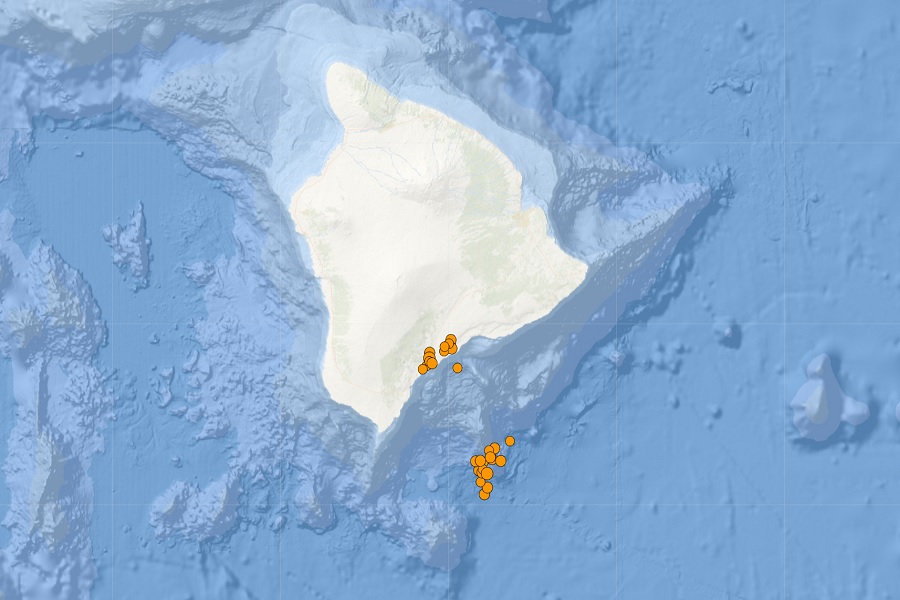
An earthquake swarm on a volcano around the Big Island of Hawaii has prompted the USGS and the Hawaiian Volcano Observatory (HVO) to issue an alert about fresh activity on Kama’ehuakanaloa. It’s been a busy 36 hours in Hawaii: Tropical Storm Darby passed nearby on Saturday while an unrelated epic swell brought waves of historic heights to south-facing shores of the state. Now, a new seismic swarm has started on Hawaii’s newest volcano, which scientists believe could be a sign that magma is on the move. In the last 24 hours, 32 earthquakes have rattled the Big Island and adjacent waters, with 18 measured over the area also known as the Lōʻihi seamount.
According to an alert issued by HVO, the increased seismic activity beneath Kamaʻehuakanaloa (Lōʻihi) seamount, south of the Island of Hawaiʻi, began at approximately 2:00 am local time on Saturday, July 16, 2022. The U.S. Geological Survey’s Hawaiian Volcano Observatory detected seismic tremor marked by pulses of seismic energy every 15-20 seconds, which was still ongoing at the time of their latest news release. Approximately 24 hours after this activity began, two dozen magnitude 1.8-3.0 earthquakes occurred from 1:30 am to 6:00 am on July 17th.
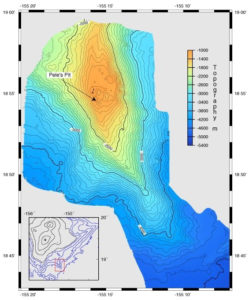
“This seismic activity is likely the result of magma movement beneath Kamaʻehuakanaloa seamount and currently shows no sign of leading to an eruption,” said According to HVO Scientist-in-Charge Ken Hon. “If the swarm intensifies or changes significantly, HVO will issue an additional notice. Because of the great depth of the volcano within the ocean and style of Hawaiian eruptions, an eruption of Kamaʻehuakanaloa would pose no threat to the Island of Hawaiʻi. Neither Mauna Loa nor Kīlauea volcanoes show any change in activity associated with this earthquake swarm.” This includes tsunami threat, which scientists say is unlikely with seismic activity at this seamount.
The entire state of Hawaii is made up of volcanoes; the Hawaiian Emperor seamount chain is a well-known example of a large seamount and island chain created by hot-spot volcanism. Each island or submerged seamount in the chain is successively older toward the northwest. Near Hawaii, the age progression from island to island can be used to calculate the motion of the Pacific Oceanic plate toward the northwest. According to NOAA, the Earth’s outer crust is made up of a series of tectonic plates that move over the surface of the planet. In areas where the plates come together, sometimes volcanoes will form. Volcanoes can also form in the middle of a plate, where magma rises upward until it erupts on the seafloor, at what is called a “hot spot.” The Hawaiian Islands were formed by such a hot spot occurring in the middle of the Pacific Plate. While the hot spot itself is fixed, the plate is moving. So, as the plate moved over the hot spot, the string of islands that make up the Hawaiian Island chain were formed.
The Hawaiian Islands form an archipelago that extends over a vast area of the North Pacific Ocean. The archipelago is made up of 132 islands, atolls, reefs, shallow banks, shoals, and seamounts stretching over 1,500 miles from the island of Hawaii in the southeast to Kure Atoll in the northwest. Kamaʻehuakanaloa is the youngest volcano in the chain and remains a submarine volcano; it’s peak is roughly 3,200 feet below sea-level about 50 miles southwest of Mauna Loa volcano, which is the world’s largest. Kamaʻehuakanaloa began forming around 400,000 years ago and is expected to begin emerging above sea level about 10,000–100,000 years from now. At its summit, Kamaʻehuakanaloa stands more than 10,000 ft above the seafloor, making it taller than Mount St. Helens was before its deadly 1980 eruption.
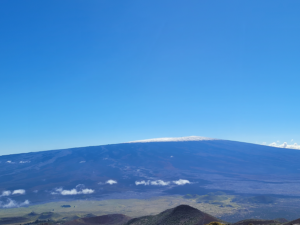
The fresh activity Kamaʻehuakanaloa is a reminder that volcanic activity is very much alive in Hawaii. While it is under water for now, three large active volcanoes grace the Big Island of Hawaii: Mauna Loa, the largest, Hualalai, the most quiet, and Kilauea, the most active of the bunch. Hawaii is also home to Mauna Kea, a dormant volcano which last erupted thousands of years ago. Mauna Kea is the tallest of the volcanoes in Hawaii and will often find its higher elevations covered under a blanket of snow.
Mauna Loa is considered the largest active volcano on Earth, rising to 13,681 feet above sea level. Mauna Loa rises up from the ocean floor of the Central Pacific at a depth of about 3 miles. Because of the volcano’s significant mass, the ocean floor directly beneath Mauna Loa is depressed by another 5 miles. According to USGS, this places Mauna Loa’s summit about 56,000 feet above its base; the enormous volcano covers half of the island of Hawaii, also known simply as the “Big Island of Hawaii.”
Mauna Loa eruptions tend to produce voluminous, fast-moving lava flows that can impact communities on the east and west sides of the Big Island from Kona to Hilo. Since the 1850s, Hilo in eastern Hawaii has been threatened by 7 Mauna Loa lava flows. On the south and west sides of the island, Mauna Loa lava flows have reached the coast there 8 times: in 1859, 1868, 1887, 1926, 1919, and three times in 1950.
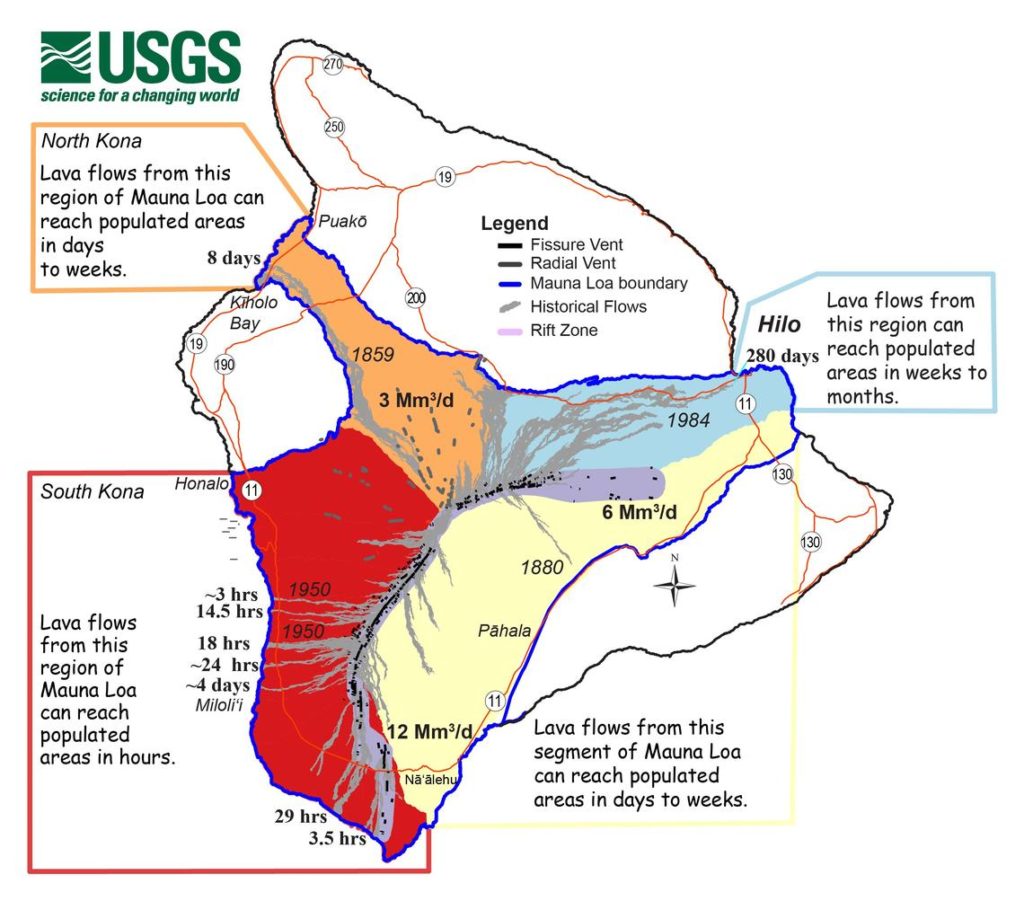
According to USGS, while Mauna Loa is not erupting right now , rates of deformation and seismicity remain elevated above long-term background levels. GPS measurements continue to show slow, long-term summit inflation consistent with magma supply to the volcano’s shallow storage system.
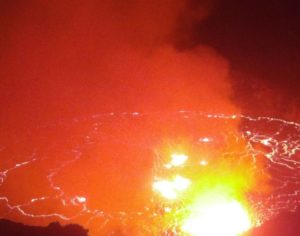
A volcano that continues to erupt though in Hawaii is Kilauea. Kīlauea Volcano, within Halemaʻumaʻu crater, has continued to erupt over the past 24 hours. According to HVO, all recent lava activity has been confined to the crater and current data indicate that this scenario is likely to continue. No significant changes have been noted at the summit or in either rift zone. Measurements from an overflight on July 7, 2022 indicated that the crater floor at Halemaʻumaʻu had seen a total rise of about 427 feet at that time, and that 25 billion gallons of lava had been effused since the beginning of this eruption on September 29, 2021.
Within the United States, the USGS tracks 161 potentially active volcanoes. The U.S. is only home to a fraction of the world’s volcanoes: according to USGS, there are normally around 2 dozen erupting volcanoes around the world at any given time. The USGS says there are about 1,500 potentially active volcanoes worldwide, with about 500 of the 1,500 erupting in modern historical times.
The Hawaii volcanoes are monitored by the Hawaii Volcano Observatory (HVO) while the Alaska volcanoes are monitored by the Alaska Volcano Observatory (AVO.) In addition to the AVO and HVO, there are also the California Volcano Observatory , Cascades Volcano Observatory, the Yellowstone Volcano Observatory, and the Northern Mariana Islands Volcano Observatory. Each of those additional volcano observatories within the USGS are monitoring volcanoes in their respective regions. At this time, none of those other observatories are reporting unusual activity or signs of anything more than background noise for now.
In the U.S., the USGS and volcano observatory units are responsible for issuing Aviation Codes and Volcanic Activity Alert Levels. Aviation Codes are green, yellow, orange, or red. When ground-based instrumentation is insufficient to establish that a volcano is at a typical background level of activity, it is simply “unassigned.” While green means typical activity associated with a non-eruptive state, yellow means a volcano is exhibiting signs of elevated unrest above known background levels. When a volcano exhibits heightened or escalating unrest with the increased potential of eruption, it jumps to orange. Finally, when an eruption is imminent with significant emission of volcanic ash expected in the atmosphere or an eruption is underway with significant emission of volcanic ash into the atmosphere, the code becomes red. Volcanic Activity Alert levels are normal, advisory, watch, or warning. As with aviation codes, if data is insufficient, it is simply labeled as “unassigned.” When the volcano is at typical background activity in a non-eruptive state, it is considered normal. If the volcano exhibits signs of elevated unrest above background level, an advisory is issued. If a volcano exhibits heightened or escalating unrest, a watch is issued while a warning is issued when a hazardous eruption is imminent.
For now, Kama’ehuakanaloa has no color code nor alert level. Kilauea is at ORANGE / WATCH while Mauna Loa is at YELLOW / ADVISORY. Hualalai is GREEN / NORMAL.